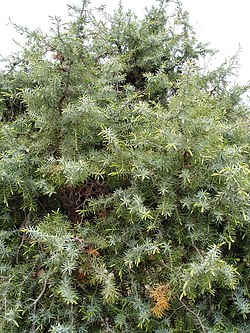| Juniperus oxycedrus | |
|---|---|
 | |
| Cade in southern France | |
| Scientific classification | |
| Kingdom: | Plantae |
| Clade: | Tracheophytes |
| Clade: | Gymnospermae |
| Division: | Pinophyta |
| Class: | Pinopsida |
| Order: | Cupressales |
| Family: | Cupressaceae |
| Genus: | Juniperus |
| Section: | Juniperus sect. Juniperus |
| Species: | J. oxycedrus |
| Binomial name | |
| Juniperus oxycedrus | |
 | |
| Natural range | |
| Synonyms [2] | |
| |
Juniperus oxycedrus, vernacularly called Cade, cade juniper, prickly juniper, prickly cedar, or sharp cedar, is a species of juniper, native across the Mediterranean region, growing on a variety of rocky sites from sea level. [3] [1] The specific epithet oxycedrus means "sharp cedar" and this species may have been the original cedar or cedrus of the ancient Greeks. [4] [5]








